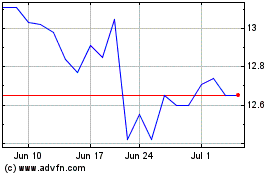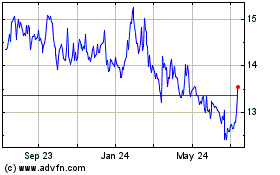Despite a series of natural disasters and consequent above-average
losses, the U.S. insurance industry could rebound only with help
from rising rates and reduced pricing pressure. Though financials
of U.S. insurance companies are still not strong enough to soak up
losses from catastrophic events such as the recent Hurricane Irene,
which affected a wide area of the U.S. East Coast, tight market
conditions and a favorable rate environment on steady demand growth
could significantly offset the damages.
Moreover, the financial dent caused by Hurricane Irene has been
milder than what the market had presumed. It wasn't as bad as it
could have been due to perfect weather forecasts and rapid
emergency actions. So the damage is expected to be mended in the
near-to-mid term.
After enduring stress with respect to pricing pressure and reduced
insured exposure through mid-2009, the overall health of the U.S.
insurance industry has improved to some extent in recent quarters.
Though the market turmoil forced many companies to take immense
write-downs, the worst of the crisis appears to be now behind
us.
However, long-lasting soft market conditions, shrinking businesses,
a still-high unemployment rate and legislative challenges are
threatening insurers’ ability to rebound to the historical growth
rate. The industry continues to be challenged by subdued premium
volume growth in a perked up economy as well as a massive
healthcare restructuring.
Though there are signs of economic recovery, its sluggish pace is
expected to continue at least through 2011. Also, structural
economies of scale have pushed the industry toward consolidation.
As a result, inter-segment competition within the industry has
reduced. Moving forward, maintaining profitability after complying
with regulatory requirements could be a painful task.
We expect static growth with persistent soft market conditions to
result in further consolidation in the industry. Though there are
near-term opportunities for insurers, braced by some rapidly
growing sectors such as health care and technology, overall
industry conditions are expected to improve beyond 2011, should the
economy turn to growth post-recovery. Probably, the industry would
take a couple of years to overcome most industry challenges with
the help of an improved market mechanism.
Life Insurers
Losses in the investment portfolio and lower income from the
variable annuity business will continue to hurt earnings of life
insurers. Most life insurers have substantial exposure to
commercial real estate-backed loans and securities, which will
result in further losses in the coming quarters.
As the industry’s statutory capital levels fell sharply during the
recession, life insurance companies will need to optimize their
capital levels to address continuing challenges. In the short term,
traditional sources of capital are expected to fulfill most of what
life insurers need to stay in good shape. However, non-traditional
sources of capital will take years to help these strengthen
financials.
Moreover, regulatory changes under the Dodd-Frank Wall Street
Reform are still troubling life insurers as they pose strategic and
competitive challenges. In order to address such concerns, life
insurers may have to burn some of their financial energy.
The underlying trends amid sluggish economic recovery indicate
stability of U.S. life insurers over the medium term with respect
to credit profile and financial prospects. However,
higher-than-average asset losses of life insurers, primarily a
result of real estate exposure, will remain a major concern in
2011.
Most importantly, the tardy economic recovery is making it
difficult for life insurers to enhance their customer base. Even
they are struggling to retain their existing clientele. Narrowed
disposable income owing to high unemployment and huge credit card
debt has made it difficult for Americans to invest in retirement
products such as life insurance.
On the other hand, interest in cheaper products to cover only basic
risks has increased. So, returning to providing basic services and
reducing operating costs should be the primary course of action for
life insurers to realize some profit in the near term.
Some life insurers have already gone back to the basics in order to
meet demand and escape financial and regulatory difficulties, but
taking shelter from the icy winds will not be adequate for
thriving. Life insurance companies have to be more proactive to
weather the situation.
Health Insurers
The U.S. health care system is significantly dependent on private
health insurance, which is the primary source of coverage for most
Americans. More than half of U.S. citizens are covered under
private health insurance.
Unfortunately, these insurance companies utilize a pre-existing
exemption clause to control costs and maximize profit. The historic
health care legislation, which was passed by Congress last year,
prevents private insurance companies from using the pre-existing
clause, but at the same time brings in 32 million more people under
coverage.
In total, the health care reform packs 95% Americans under health
insurance coverage. Further, according to a new Commonwealth Fund
report, 90% of American families live above the federal poverty
level and are able to afford health insurance premiums.
While the legislative overhaul brings more regulatory scrutiny for
private insurance companies, the net negative effect is far softer
than was initially feared. Also, the removal of this uncertainty is
a net positive in its own right.
Though the reform will provide more cross-selling opportunities for
health insurers, their overall profitability will be marred in the
long run as the negative impact of Medicare Advantage payment cuts,
industry taxes and restrictions on underwriting practices will more
than offset the benefits of the 32 million added coverage.
In August, Fitch Ratings said that it expects the publicly traded
health insurers and managed care companies to generate strong
earnings and interest coverage in the second half of 2011. Though
minimum loss ratio requirements will remain a dent, the agency
expects this to be offset by membership growth.
According to the agency, cash flow generated by most of the health
issuers is more than sufficient to meet their ongoing business
needs. As a result, an addition of meaningful leverage to their
balance sheets is unlikely.
However, industry revenue is expected to decline beyond 2011
through 2015 as insurers will be forced to adjust these to comply
with the health care legislation. Among others, providing coverage
to everyone regardless of whether they had an expensive
pre-existing condition would put their top line at stake.
Property & Casualty Insurers
Steep losses in the investment portfolios since the beginning of
2008 have significantly reduced the capital adequacy of most
Property & Casualty insurers. The seizure of credit markets and
rising concerns over defaults have pushed down bond prices sharply
since then, causing significant realized and unrealized capital
losses on insurer portfolios. As Property & Casualty insurers
hold about two-thirds of the invested assets in the form of bonds,
their capacity is highly sensitive to changes in credit market
conditions.
While the ongoing recovery in the credit and equity markets is
leading to a reduction in unrealized investment losses, the premium
rates continue to decline, though at a slower pace.
Reduced financial flexibility and weak underwriting and reserves
have further added to insurer woes. The only positive trend visible
as of now is a slight improvement in some insurance pricing after
continued deterioration for two years since 2008.
However, the Property & Casualty industry endured the recent
financial crisis better than the other financial service sectors.
Once the economic recovery gains momentum, insurance volume will
grow rapidly.
The recent quarters have been witnessing increasing rebound in
claims-paying capacity (as measured by policyholders’ surplus),
which reflects the industry’s resilience over the prior-years.
Earlier this month, Moody's Investors Service, a wing of
Moody’s Corp. (MCO) revised its outlook for U.S.
Commercial Lines Insurers to stable from negative. According to the
rating agency, the sector weathered the recent financial crisis
better than other insurance sectors despite challenges related to
catastrophes, underwriting and capital market volatility.
Besides benefiting from the recent stabilization of industry-wide
pricing, commercial insurers maintain solid capital adequacy and
balance sheet strength.
Reinsurers
Losses from the investment portfolios of reinsurance companies have
gotten worse during the last few quarters. The supply-demand
imbalance in reinsurance coverage due to intense competition had
kept pricing soft over the last few years.
Also, catastrophic events like Hurricanes Ike and Gustav were the
major culprits that pressure on underwriting profits. However, in
the recent months, reinsurance prices have increased substantially.
In fact, rising rates are expected to be more than sufficient to
offset recent catastrophe losses.
With signs of recovery in the capital market (though still weak by
any means), concerns related to reinsurers' ability to access
capital markets on reasonable terms have sufficiently eased.
Earlier this month, Moody’s Investors Service, had revised their
outlook on the international reinsurance sector to stable from
negative based on strong risk management and underwriting
discipline showed by the industry in the prior year. Also, the
agency expects increased demand to boost reinsurance rates.
However, diminishing new business and rising expense ratios are
major concerns for reinsurers at this point. An increased level of
price competition also may hurt top line in the upcoming
quarters.
OPPORTUNITIES
We remain positive on
Eastern Insurance Holdings,
Inc. (EIHI),
RLI Corp. (RLI),
ProAssurance Corporation (PRA),
Investors
Title Co. (ITIC) and
Donegal Group Inc.
(DGICA) with a Zacks #1 Rank (short-term Strong Buy).
Other insurers that we like with a Zacks #2 Rank (short-term Buy)
include
CIGNA Corporation (CI),
CNO
Financial Group, Inc. (CNO),
FBL Financial Group
Inc. (FFG),
American Safety Insurance Holdings
Ltd. (ASI),
AmTrust Financial Services,
Inc. (AFSI),
First American Financial
Corporation (FAF) and
Mercury General
Corporation (MCY).
American International Group Inc. (AIG) currently
retains a Zacks #3 Rank which translates into a short-term Hold
rating.
WEAKNESSES
We expect continued pressure on investment portfolios and lower
income from the variable annuity business to restrict the earnings
growth rate of life insurers. Also, reduced financial flexibility
and weak underwriting will hurt the earnings of Property &
Casualty Insurers.
Among the Zacks covered U.S. insurers, we prefer to stay away from
the Zacks #5 Rank (short-term Strong Sell) companies ––
Horace Mann Educators Corp. (HMN),
AXA (AXAHY),
SeaBright Holdings,
Inc. (SBX) and
Amerisafe Inc. (AMSF).
AMTRUST FIN SVC (AFSI): Free Stock Analysis Report
AMER INTL GRP (AIG): Free Stock Analysis Report
AMER SAFETY INS (ASI): Free Stock Analysis Report
CIGNA CORP (CI): Free Stock Analysis Report
CNO FINL GRP (CNO): Free Stock Analysis Report
DONEGAL GRP -A (DGICA): Free Stock Analysis Report
EASTERN INSURNC (EIHI): Free Stock Analysis Report
FIRST AMER FINL (FAF): Free Stock Analysis Report
FBL FINL GRP-A (FFG): Free Stock Analysis Report
HORACE MANN EDS (HMN): Free Stock Analysis Report
INVESTORS TITLE (ITIC): Free Stock Analysis Report
MOODYS CORP (MCO): Free Stock Analysis Report
MERCURY GENL CP (MCY): Free Stock Analysis Report
PROASSURANCE CP (PRA): Free Stock Analysis Report
RLI CORP (RLI): Free Stock Analysis Report
Zacks Investment Research
Donegal (NASDAQ:DGICA)
Historical Stock Chart
From Mar 2024 to Apr 2024

Donegal (NASDAQ:DGICA)
Historical Stock Chart
From Apr 2023 to Apr 2024
